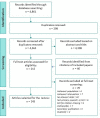Clinical, humanistic and economic outcomes, including experiencing of patient safety events, associated with admitting patients to single rooms compared with shared accommodation for acute hospital admissions: a systematic review and narrative synthesis
- PMID: 37147093
- PMCID: PMC10163491
- DOI: 10.1136/bmjopen-2022-068932
Clinical, humanistic and economic outcomes, including experiencing of patient safety events, associated with admitting patients to single rooms compared with shared accommodation for acute hospital admissions: a systematic review and narrative synthesis
Abstract
Objectives: Assess the impact of single rooms versus multioccupancy accommodation on inpatient healthcare outcomes and processes.
Design: Systematic review and narrative synthesis.
Data sources: Medline, Embase, Google Scholar and the National Institute for Health and Care Excellence website up to 17 February 2022.
Eligibility criteria: Eligible papers assessed the effect on inpatients staying in hospital of being assigned to a either a single room or shared accommodation, except where that assignment was for a direct clinical reason like preventing infection spread.
Data extraction and synthesis: Data were extracted and synthesised narratively, according to the methods of Campbell et al. RESULTS: Of 4861 citations initially identified, 145 were judged to be relevant to this review. Five main method types were reported. All studies had methodological issues that potentially biased the results by not adjusting for confounding factors that are likely to have contributed to the outcomes. Ninety-two papers compared clinical outcomes for patients in single rooms versus shared accommodation. No clearly consistent conclusions could be drawn about overall benefits of single rooms. Single rooms were most likely to be associated with a small overall clinical benefit for the most severely ill patients, especially neonates in intensive care. Patients who preferred single rooms tended to do so for privacy and for reduced disturbances. By contrast, some groups were more likely to prefer shared accommodation to avoid loneliness. Greater costs associated with building single rooms were small and likely to be recouped over time by other efficiencies.
Conclusions: The lack of difference between inpatient accommodation types in a large number of studies suggests that there would be little effect on clinical outcomes, particularly in routine care. Patients in intensive care areas are most likely to benefit from single rooms. Most patients preferred single rooms for privacy and some preferred shared accommodation for avoiding loneliness.
Prospero registration number: CRD42022311689.
Keywords: Economics; HEALTH ECONOMICS; Health policy; Organisation of health services; Quality in health care.
© Author(s) (or their employer(s)) 2023. Re-use permitted under CC BY-NC. No commercial re-use. See rights and permissions. Published by BMJ.
Conflict of interest statement
Competing interests: None declared.
Figures





References
-
- Ewbank L, Thompson J, McKenna H, et al. Nhs Hospital bed numbers: past, present, future. The King’s Fund 2021. Available: https://www.kingsfund.org.uk/publications/nhs-hospital-bed-numbers
-
- UK Government . Pm confirms £3.7 billion for 40 hospitals in biggest Hospital building programme in a generation. 2020. Available: https://www.gov.uk/government/news/pm-confirms-37-billion-for-40-hospita...
Publication types
MeSH terms
Grants and funding
LinkOut - more resources
Full Text Sources
Medical
